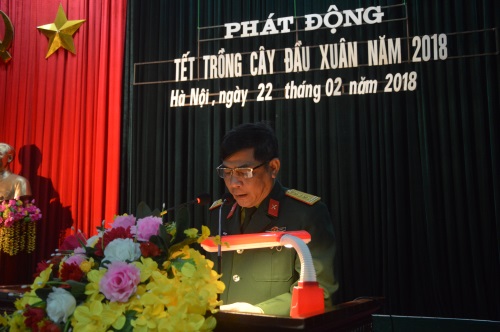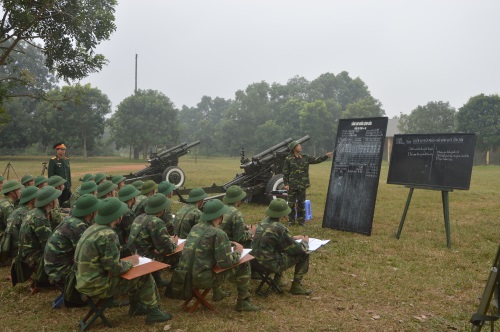Artillery College (AC) is tasked with training artillery command – staff officers for the military. In recent years, the College’s leadership has implemented various approaches and plans to comprehensively enhance its overall strength. Accordingly, the work of building standardization and maintaining discipline have been the main focus and resulted in many encouraging outcomes. Consequently, these successes have created favorable conditions for the College to implement fundamental and extensive reforms in training and accomplish its assigned tasks.
Standardization building has been concretized to make it relevant to its functions and objectives, with emphases being placed on: building a healthy educational environment; imposing strict discipline; and creating a clean, green, and scenic surrounding. To accomplish these tasks, the College’s Board and Party committee instructed their subordinate detachments to enhance the sense of responsibility and sense of duty for cadres, instructors, cadets, and soldiers in the task of standardization building. To that end, units at all levels implemented activities to educate its members about the importance of standardization to the accomplishment of the College’s political tasks and to the quality of future artillery officer corps. These educational activities aimed for the comprehension of instructions and guidelines on standardization building and maintaining discipline issued by superior commands, such as: Minister of National Defense’s Guideline 917/CT-BQP on comprehensive unit building; or Minister of National Defense’s Guideline 04/CT-BQP on the enhancement of monitoring, educating, and maintaining discipline, and preventing criminal activities in the military, etc. To ensure the success of these activities, the College applied various flexible propaganda and education approaches; combining general education with specified education, basic education with regular education in its members’ day-to-day business; notably, freshman cadets, newly conscripted recruits, and artillery officer cadets were the main focus of these activities. Especially, the College has developed a number of creative propaganda and education subjects to improve service members’ mentality and morale, creating significant advancement in their consciousness and action.
 |
Senior Colonel Vu Ky Ve launching the planting movement
of the Artillery College |
Over the past few years, AC has pushed ahead the implementation of “3 breakthroughs, 2 accomplishments and 1 no”, focusing on standardization building and maintaining discipline. The College developed action plans and programs to realize these tasks and ordered its administrative departments and faculties to embed standardization building into their regular leadership resolutions; and instructed cadet battalions to issue themed resolution on “the enhancement of standardization building, maintaining discipline, and the compliance of State’s legislations and military disciplines”. Base on instructions issued by the College’s Board, Party Committee, battalions, departments and faculties conducted evaluation on their own performance in standardization building and maintaining discipline; exploring weaknesses and their causes to propose appropriate solutions. In addition, the College’s leadership assigned specific tasks and responsibilities for its subordinate commands. Also, the result of standardization building and maintaining discipline at grassroots units was embedded into criteria for evaluating the task performance of their commanding officers, and individual discipline was considered as a crucial factor in assessing cadres and instructors’ task accomplishment, and in approving cadets’ Party membership submission.
To ensure the unity of command in implementing the task, the College’s leadership actively developed, enhanced and completed standardization building and maintaining discipline mechanisms and regulations. Based on superior commands’ guidelines and decrees, the College’s Board and Party Committee complemented leadership mechanisms for primary works, such as: personnel, training – education, finance, military science study, etc. Besides, administrative departments were instructed to work with faculties and cadet battalions to develop other regulations for related works, such as: regulation for curriculum implementation, regulation for testing paper bank; regulation for administrative department, faculty and cadet unit cooperation; and many other regulations for training, study, working schedule, or military dress code, etc.
Also, the College’s leadership attached importance to promoting the responsibility and exemplary role of cadres and Party members, especially company and battalion commanding officers, in standardization building and maintaining discipline. Acoordingly, cadres and Party member were required to be moral examples in daily living and working, in complying military discipline and units’ regulations. To that end, they must have methodical working style, befriend with their subordinate, regularly inspect their units, and avoid any sign of subjectivity and negligence, etc, to develop their own discipline and law-abiding living and working style. In addition, the College upheld the role of company-level cadres and instructors, realizing mottos such as: “Superior rank is the the example to subordinates”; “Cadre is the example to cadets”; and “Instructor is the role model to cadets”. To meet demanding requirements of standardization building and maintaining discipline, the AC organized many training sessions to enhance leadership ability for commanding officers, especially company commanders and class monitors. These sessions focused on methods to realize superior authorities’s guidelines and instructions into actual plans and activities; approaches to monitor, analyze and assess the mentality of subordinate military memebers, etc. Besides, the College has sent many cardres to leadership and management training classes held by superior commands, or to artillery units to gain experience and knowledge to improve their leadership skills; and organized several events with nearby miltary units to learn, exchange and discuss experience in standardization building and maintaining discipline.
To create a sustanable foundation for standardization building and maintaining discipline, AC strictly imposed working regimes and regulations. Accordingly, the College’s leadership instructed its subordinate detachments to conduct reforms in working manner and administrative proccess; and sychronize administrative forms and simplify administrative procedures to improve working effectiveness. Also, administrative departments and battalions were required to closely follow daily and weekly working regimes; especially those related to training and combat readiness duty. To further enhance working performance, the AC leadership ordered administrative departments, faculties and battalions to closely cooperate in every activity, especially in training, material assurance, and cadet management. Also, it promoted the role of Operation and Discipline Board in inspecting and monitoring the implementation of military dress code and working regimes; of Training Inspection Board in conducting training, tests and exams, etc. At the same time, cadet battalions established Discipline Team to work with the guard company and duty members of departments, faculties and units to inspect and monitor soldiers’ dress code and conducts, especially at weekends, on holidays or afterhour. For further positive progresses, the College leadership proposed the development and proliferation of model units. In 2017, Battalion 3 was chosen to develop a comprehensive model unit; Battalion 2 was developed to be a model unit in standardization building; and Battalion 1 was selected to build a model unit of civilized environment. These model building activities later was evaluated to provide lessons to expand the movement to the whole College. Besides, AC actively cooperated with the local authority and people to grasp the surrounding socio-economic condition to apply appropriate measures to monitor its cadets and soldiers and prevent social evils inside the College. On the other hand, administrative departments and battalions were required to report every incident occurred and work with the Staff – Administrative Department and the Internal Security Board to strictly, correctly and publicly penalize any violations to enhance the effect of discipline in deterrence and education.
 |
| A training session on the 105mm Howitzer |
As a primary training unit of the military, AC always emphasizes on combining training and education with disciplining. Base on the Regulations for Cadet Management Coordination, the College leadership instructed departments, faculties and battalions to cooperate in monitoring cadets in any activity in classrooms, on training fields or in their barracks. In addition, faculties and battalion worked together to correctly implement training curriculum; fully grasp cadets’ training and discipline performance, especially the seniors to apply suitable measures to improve and enhance their discipline and training result. Also, cadets’ academic results are embedded into criteria for Party membership registration, vacation permission and their discipline performance and morality were selected as a criterion to evaluate graduation ranking. Besides, the College introduced several models to create a healthy and civilized environment for its members, enabling them to self-complement and enhance their working manner, for example: Threesome, Perfect Couple; English Club, Guitar Club, etc.
Additionally, to facilitate the work of standardization building, AC actively mobilized various resources to upgrade and standardize its training and subsistence infrastructure and equipment. Over the past few years, the entire classroom complex has been upgraded; the system of working offices, barracks and internal roads has been newly constructed; and many sign plates and panels have been erected, etc, to enhance the standardization and synchronization inside the College and created a “bright, green, clean and scenic” environment.
With the assertive implementation of all measures mentioned above, over the past few years, AC has always been one of the most successful units in standardization building and maintaining discipline in the entire Artillery Corps. The rate of military members violating normal discipline codes in the College is only under 0.01%, neither social evil-related case nor traffic accident was reported, and the rate of successful registration for Party membership among its cadets is 100%. These encouraging results are truly a solid foundation for further successes of AC in its training tasks meeting the new requirements in the new situation.
Senior Colonel, Associate Professor, Doctor Vu Ky Ve, AC Rector